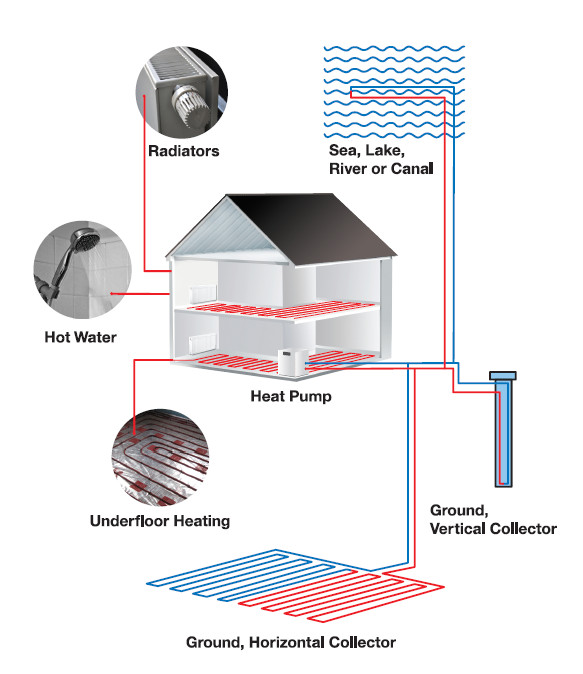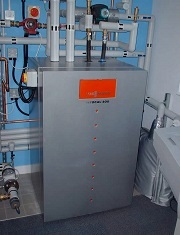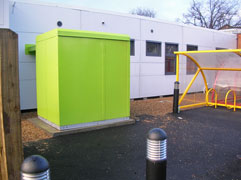Domestic Ground Source Heat Pumps

How does a GSHP work?
A Ground Source Heat Pump transfers heat from the ground into buildings.
Radiation from the sun heats the earth. The earth then stores the heat and maintains, just two metres or so down, a temperature of around 10°C even throughout the winter. A ground source heat pump uses a ground heat exchange loop to tap into this constantly replenished heat store to heat buildings and provide hot water. The technology used is the same as that used in refrigerators. Just as a fridge extracts heat from the food and transfers it into the kitchen, so a ground source heat pump extracts heat from the earth and transfers it into a building.
How efficient are Ground Source Heat Pumps?
For every unit of electricity used by the heat pump, three to four units of heat are captured and transferred: a well installed ground source heat pump system can deliver four times the amount of heat as using a direct electric bar heater. At this efficiency level there will be 75% lower carbon dioxide emissions than for a gas boiler heating system. If the electricity is provided by renewable energy, then carbon emissions can be reduced to zero.
What do they look like?
A Ground Source Heat Pump system comprises three basic elements – a ground heat exchange loop, the heat pump itself which concentrates available heat from the ground, and a heat distribution system.
The ground loop is a pipe buried underground in a horizontal trench or a vertical borehole. Horizontal trenches are dug two metres below ground level and, although needing more land area than a borehole, they are usually cheaper for smaller systems.
Boreholes are drilled to a depth of 50 to 180 metres and may benefit from higher ground
temperatures than trenches.
There are a variety of types of pipe which can be used in a trench instead of a straight one, which increase the
amount of heat absorbed from the ground and so enhance performance. The ground area required
for trenches will vary with the location, the property and the heat output required. As a general
guide, for a newly built 3-bedroomed house of around 120 m

A water/anti-freeze mixture is circulated through the pipe where it absorbs heat from the ground. A heat exchanger then extracts the absorbed heat and transfers it to the heat pump. The third basic element of a ground source heat pump, the heat distribution system, can be either radiators or underfloor heating. If the heat pump is asked to produce higher temperatures, for a conventional radiator circuit, then its efficiency will be lower than if it is asked to circulate warmth to generously sized radiators or underfloor heating. As many existing houses have generously sized radiators it may not be necessary to increase them when a heat pump is installed. Because heat pumps work more efficiently at lower temperatures than boilers it will generally be beneficial to set the time clocks to start heating earlier than with a boiler system.
Once a ground source heat pump is installed, there are no external fans and no external equipment is visible. The system is quiet in operation, issues no emissions, is very safe and requires very little maintenance.
Installation Costs
The installation costs will depend on the site and the amount of heat output required. A site survey is necessary to determine which type of collector (horizontal trenches, vertical borehole, water-source or open-loop) is most appropriate. As a guide, the installed cost of a horizontal gshp system is likely to be in the range £1,250 - £1,750 per kW of capacity, with that for a vertical borehole closed-loop system in the range £1,750 - £3,000 per kW. However, the cost will be specific to the type of property and technical approach chosen. The Boiler Upgrade Scheme grant of £6,000 is a financial encouragement to install ground source heat pumps.
GSHPs can be installed anywhere in the UK, using a borehole or shallow trenches or, less commonly, by extracting heat from a pond or lake. Heat collecting pipes in a closed loop, containing water (with a little antifreeze) are used to extract this stored energy, which can then be used to provide space heating and domestic hot water. Heat pumps can also be reversed in summer to provide cooling.
Ground source heat pumps have been widely used in North America, Norway, Sweden, France, Germany and Switzerland for many years. Typically they cost more to install than conventional heating systems. However, they have very low maintenance costs and can be expected to provide safe, reliable and emission-free heating for well over over 20 years, with the ground loop lasting at least 100 years.
Running Costs
The running cost of a well designed ground source heat pump system is lower than for any other space heating system, whether fossil fuel based or renewable.
The only energy used by a ground source heat pump that you pay for is electricity to power the compressor and the circulation pumps which transfer heat energy from the ground into the building. A well designed ground source heat pump installation will deliver three or four times as much thermal energy (heat) as is used in electrical energy to drive the system. For a particularly environmental solution, green electricity can be bought.
Ground source heat pumps work best with heating systems which are optimised to run at a lower water delivery temperature than is commonly used in traditional radiator systems. As such, they make an ideal partner for underfloor heating or "oversized" radiators. However, plumbers have traditionally installed larger radiators than needed for gas boiler fired systems, so repacing a gas boiler with a heat pump will probably not require additional radiators.
The Advantages of Ground Source Heat Pumps
Ground Source Heat Pumps save money. Heat pumps are much cheaper to run than direct electric heating systems. GSHPs are cheaper to run than oil boilers, burning coal, LPG or gas.
Because heat pumps can be fully automated they demand much less work than biomass boilers.
Heat pumps save space. There are no fuel storage requirements.
No need to managed fuel deliveries. No risk of fuel being stolen.
Heat pumps are safe. There is no combustion involved and no emission of potentially dangerous gases. No flues are required.
GSHPs require less maintenance than combustion based heating systems. They also have a longer life than combustion boilers. The ground heat exchanger element of a ground source heat pump installation has a design life of over 100 years.
Heat pumps save carbon emissions. Unlike burning oil, gas, LPG or biomass, a heat pump produces no carbon emissions on site (and no carbon emissions at all, if a renewable source of electricity is used to power them).
GSHPs are safe, silent, unobtrusive and out-of-sight: they require no planning permission.
Heat pumps can also provide cooling in summer, as well as heating in winter.
A well designed ground source heat pump system is likely to increase the sale value of your property.
Boiler Upgrade Scheme – BUS
The Boiler Upgrade Scheme is a financial encouragement to install ground source heat pumps: Ofgem will pay £6,000 as an up-front grant to those who install a ground source heat pump system.
Performance of Ground Source Heat Pumps
The performance of a heat pump is measured under standard conditions as the "coefficient of performance": this measures the heat output in kilowatts in relation to the electrical input in kilowatts. However, the CoP of a heat pump is greatly influenced by the output temperature delivered to the heat distribution system in the building and the input temperture from the heat source.
In cold conditions a ground source heat pump with access to a temperture of 10°C from the ground will deliver a significantly higher CoP than an air source heat pump with access to -5°C from ambient air. The design, installation quality and controls of a ground source heat pump installation are critical to achieving good performance.
Installation of Ground Source Heat Pumps
To get the full benefit of a GSHP installation you will need to employ someone with design and installation experience. A ground source heat pump may not perform well unless it is incorporated in a good design by someone who understands the needs of the building and the local geology.
A well installed ground source heat pump installation can provide sustainable energy over the whole life of a building.
Good design is critical to achieving high performance from ground source heat pumps.
See also: Ground Source Heat Pump Systems
See also: Boiler Upgrade Scheme



